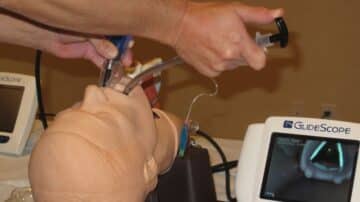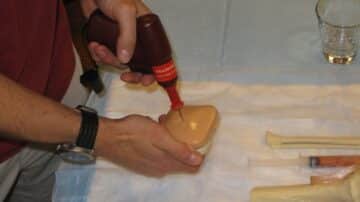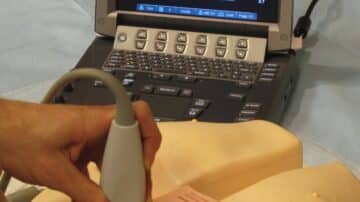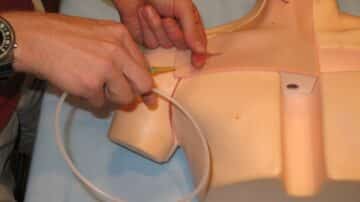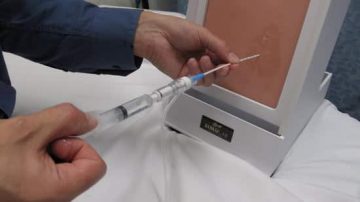Lumbar punctures (LPs) are a common medical procedure that is used to collect cerebrospinal fluid (CSF) to diagnose and manage neurological illnesses. Here, we delve into the results of a new study on the safety of LPs for patients undergoing…
Read MoreFever can be a serious complication in infants aged three months or younger. Immediate medical intervention is necessary to treat the possible infection, although clinical evaluation can be quite a conundrum. This is because there’s no way of knowing what…
Read MoreConditions like congestive heart failure, pneumonia, cancer, and lupus can cause excess fluid to accumulate in the pleural space or area between the lungs and chest wall. To aspirate fluid from a pleural effusion, a medical procedure known as thoracentesis…
Read MoreVideolaryngoscopy has quickly become a popular method for airway management because it provides better visuals of the glottis. Failed intubations have decreased since more clinicians have begun to rely on videolaryngoscopy and the greater visibility it provides. Awake videolaryngoscopy is…
Read MorePOCUS stands for Point of Care Ultrasound. It refers to the use of portable ultrasound machines at a patient’s bedside or point of care to help diagnose and manage medical conditions. POCUS is often used in emergency and critical care…
Read MoreIntraosseous lines are commonly associated with decreased return of spontaneous circulation or ROSC rates compared to peripheral IV access. Intraosseous lines have also been linked to decreased survival after out-of-hospital and in-hospital cases of cardiac arrest in comparison to IV…
Read MoreTraditionally, traumatic hemothorax treatment called for the insertion of a 36-French (36F) to 40F large-bore chest tube (CT). In this article, we’ll delve into a study that shows how 14F percutaneous catheters (P-CATs or PCs) or pigtail catheters have equal…
Read MoreWhile vasopressors are typically administered through a central venous catheter (CVC), peripheral intravenous (PIV) administration is becoming more common in clinical practice. The safety of this administration method is now well-established and is a good alternative to CVC placement for…
Read MoreMore Tags – Alternatives to PICC, alternatives to picc line, Internal Jugular Central Line, PICC in patients who may need hemodialysis, PICC in patients with chronic kidney disease, picc line for dialysis, picc line placement, PICC line placement for long-term vascular access, Subclavian Central Line
A peripherally inserted central catheter (PICC) line refers to a type of central line that is used for long-term vascular access in patients with chronic kidney disease (CKD). However, the American Board of Internal Medicine’s (ABIM) Choosing Wisely campaign recommends…
Read MoreBrachial arterial catheterization is widely chosen for constant blood pressure and hemodynamic monitoring in critically ill patients. It provides real-time measurements of physiologic parameters with a very low incidence of associated risks or complications. In this article, we will revisit…
Read MoreCentral line insertion can be a complicated process that requires proper training to minimize procedural risks. One of its most important aspects is the proper positioning of the patient during the procedure to ensure safety and success. Patients may also…
Read MoreMore Articles – Cardiovascular diseases, Chest Tube, Emergency Procedures, Events, Featured, King Tube, Medical General, medical procedures
Thoracostomy or the insertion of chest tubes (CTs) is a frequent procedure in clinical practices. After inserting chest tubes in the patient’s pleural cavity, they become a route for administering antibiotics, sclerosing agents, fibrinolytics, and saline. Meanwhile, indwelling pleural catheters…
Read MoreFor procedures involving lumbar punctures , sonographically guided lumbar punctures (SGLPs) have a higher propensity of being chosen when dealing with obese patients. This is based on findings of a randomized controlled trial conducted in 2007. The main takeaway from…
Read MoreThe emergency room (ER) is an essential area of any hospital because it often deals with life-and-death situations. How medical personnel respond significantly affects the prognosis of patients who are in need of urgent care. As a medical professional, experience…
Read MoreMore Articles – Cardiovascular diseases, Central line, Featured, medical procedures, Nephrology, Respiratory diseases, Thoracentesis
There are two myths that have persisted about thoracentesis and pleural fluid analysis that must be dispelled. The first myth is that a large volume thoracentesis should not remove more than 1,500 mL fluid due to the risk of re-expansion…
Read MoreCategories
- ACLS (1)
- Arterial line (33)
- Cardiovascular diseases (77)
- Central line (55)
- Chest Tube (39)
- Dermatology (4)
- Emergency Procedures (138)
- Endocrinology (6)
- Endotracheal Intubation (36)
- Events (24)
- FAST Exam (12)
- Featured (111)
- Featured Procedure (42)
- Gastrointestinal diseases (32)
- Ginecology (3)
- Glidescope Intubation (21)
- Hematology (33)
- Hospital Procedures (85)
- Infections (32)
- Intraosseous line (8)
- King Tube (27)
- Laryngeal Mask Airway (18)
- Lumbar Puncture (36)
- Mechanical Ventilation (34)
- Medical General (95)
- medical procedures (257)
- Needle Decompression (6)
- Nephrology (11)
- Neurological diseases (12)
- Oncology (4)
- Paracentesis (32)
- Pericardiocentesis (3)
- Procedural Sedation (19)
- Respiratory diseases (85)
- RUSH Exam (8)
- Thoracentesis (37)
- Traumatology (24)
- Travel (27)
- Ultrasound-Guided Peripheral IV (13)




